Cataract
Cataracts are one of the most common causes of blurred vision over the age of 50. Although there is no medicine or diet to cure cataracts, surgical removal of the cataract and replacement with a permanent artificial lens implant can restore lost vision. Eventually, everyone will develop a cataract if you live long enough.
What causes cataracts?
Some cataracts are caused by birth defects, injuries, diabetes, or prolonged use of certain medications, such as steroids. Highly nearsighted patients may develop cataracts at a young age. However, most cataracts result simply from the natural aging process of the human lens. Like gray hair, cataracts are not a disease, nor do they occur at the same age or rate in everyone.
When should cataracts be removed?
The decision to have cataracts removed is one hundred percent elective. As cataracts do not harm other parts of the eye, nothing needs to be done if you are not significantly bothered by symptoms. However, as activities such as driving and reading become increasingly affected by cataracts, surgery becomes a logical option to consider.
Since cataracts will not improve and will eventually worsen, there is no advantage in delaying treatment if vision is sufficiently affected and the prognosis of surgery is good. You are never “too old” to have cataract surgery, just as you are never “too old” to enjoy better vision.
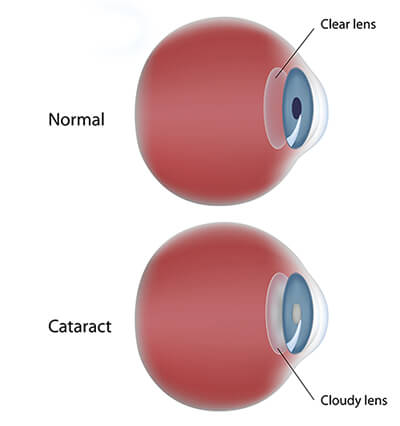
Lens Implants
The modern intraocular lens (IOL) “implant” does not change the appearance or sensation of the eye. The implant is permanent, and takes place of the cloudy lens. Unlike a contact lens, it cannot fall out and does not require cleaning.

FAQ
What is a cataract?
What causes blurred vision?
Just as defective film will spoil photographs, retina or nerve conditions such as macular degeneration, epiretinal membrane, or glaucoma will cause blurred vision in eyes despite a clear lens and proper focus (glasses). Good vision always requires (1) optimal focus – usually with glasses, (2) a clear lens, and (3) a healthy retina and nerve.
What are the symptoms?
What causes cataracts?
What is “small incision” cataract surgery?
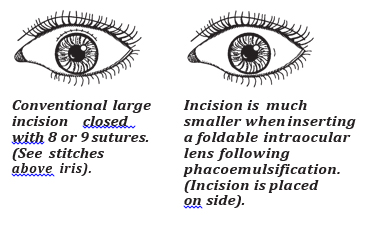
What is the experience of surgery like?
I generally employ topical or needle-free anesthesia for cataract surgery. The eye is numbed by anesthetic drops. Thanks to light sedation, you will feel calm and relaxed but be awake enough to cooperate. Since your lids are gently held open, you will see light but not the operation itself. This advanced method eliminates sutures, anesthetic injections, eye bandages, and postoperative restrictions for most patients. An additional numbing injection can be performed if you need it for your comfort. Because the surgery usually takes less than 30 minutes, even patients in poor health can successfully undergo cataract surgery.
How does the eye work?
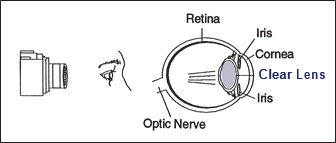
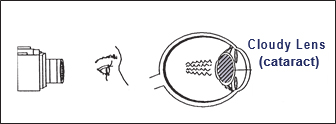
When should cataracts be removed?
With the success of the modern implant, waiting for cataracts to ripen is no longer necessary. Because cataracts will not improve and will eventually worsen, there is no advantage in delaying treatment if vision is sufficiently affected and the prognosis of surgery is good. You are never too old to have cataract surgery, just as you are never too old to enjoy better vision.
What is a “lens implant”?
The “prescription” or power of each patient’s implant is selected based on computer calculations that use a series of precise eye measurements performed in the office prior to surgery. The distance between the front of the eye and the retina can be measured precisely using optical methods. This painless test is called biometry.
Recently, newer implant designs that can decrease your dependence upon glasses have become very popular. However, they are not appropriate for all individuals, and the additional cost is not covered by insurance.
How is surgery performed?
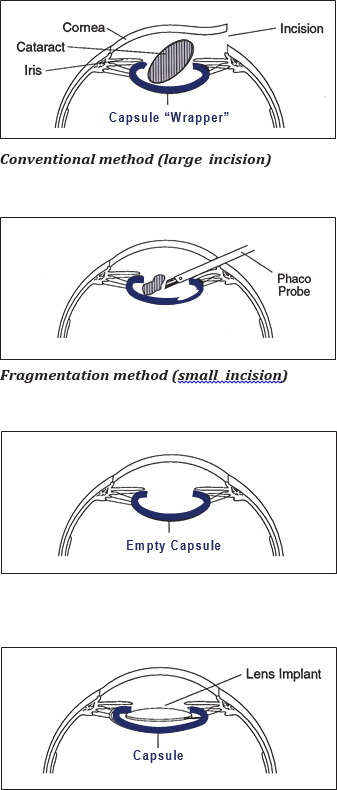
What are the risks of cataract surgery?
What is the recovery like following surgery?
As with any surgery, the healing period will vary with each individual. Use of the eye is not harmful, but the vision is normally blurry at first. Your eyeglass prescription will be different after surgery and will be changed approximately one month later.
